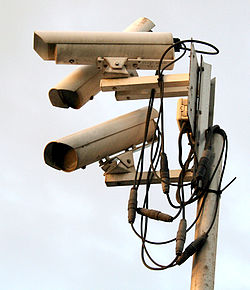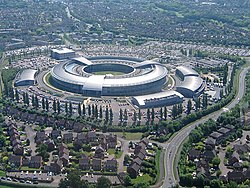Surveillance
Surveillance means watching someone or something.[1][2] It may be secret, and many methods are used including telephone tapping to listen to the person's calls and putting an electronic listening device, a bug, into a room.
Governments and the military have built large facilities designed to listen in to communications between other governments and military groups. For example the U.S. has a large base at Pine Gap near Alice Springs, Australia, which listens to communication signals from all over the world.
Eavesdropping is also surveillance, but often without much planning. It means listening to things you aren't supposed to hear. It is a deliberate act, rather than simply overhearing someone else talking.
Surveillance methods

Many people engage in surveillance for many purposes.[3] That purpose may be crime prevention, alerting for attacks, or general gathering of information for a political purpose. The results of surveillance are sometimes called "intelligence". Surveillance collects information for law enforcement, intelligence agencies, military planners or commercial firms.[4]
This may include observation from a distance by means of electronic equipment (such as CCTV cameras), or interception of electronically transmitted information (such as internet traffic or phone calls).
Surveillance may include simple, relatively low-technology methods such as watchtowers, human intelligence agents and postal interception. On the other hand, global surveillance is done by satellite cameras on a daily basis. Such satellites are called "reconnaissance satellite" or spy satellites.
The word surveillance comes from a French phrase for "watching over" ("sur" means "from above" and "veiller" means "to watch").[5][6][7]
Surveillance Media
Surveillance cameras in Gdynia, Poland
Surveillance Camera to support the Washington, DC Police
Official seal of the Information Awareness Office – a U.S. agency which developed technologies for mass surveillance
The headquarters of UK intelligence activities is Government Communications Headquarters, Cheltenham, England (2017)
A surveillance camera in Cairns, Queensland
Fingerprints being scanned as part of the US-VISIT program
Related pages
References
- ↑ /sərˈveɪ.əns/ or /sərˈveɪləns/
- ↑ OED
- ↑ Lyon, David. 2007. Surveillance studies: an overview. Cambridge: Polity Press.
- ↑ The Age of Surveillance: The Aims and Methods of Americas Political Intelligence System by Frank J. Donner (1980) ISBN 9780394402987
- ↑ Minsky M; Kurzweil R . & Mann S. 2013. The society of intelligent veillance, Proceedings of the IEEE. ISTAS. Toronto, Ontario, Canada, pp13-17.[1] Archived 2017-10-19 at the Wayback Machine
- ↑ Clarke R. 1988. Information technology and dataveillance. Communications of the ACM, 31(5), 498-512.
- ↑ Michael K. et al 2010. Planetary-scale RFID services in an age of uberveillance. Proceedings of the IEEE, 98(9), 1663-1671.[2]










